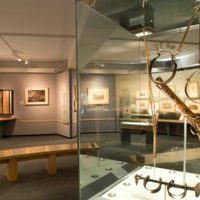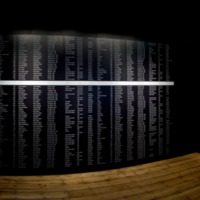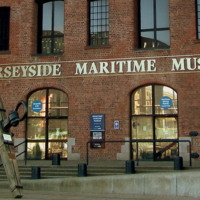
National Maritime Museum
The National Maritime Museum is the largest maritime museum in the world. It forms part of the Royal Museums Greenwich UNESCO World Heritage Site. The NMM houses ten galleries that all showcase Britain’s Maritime History. Its mission is 'to enrich people’s understanding of the sea, the exploration of space, and Britain's role in world history’. ‘The Atlantic Worlds Gallery,' launched in 2007 for the commemoration of the bicentenary, charts the interconnections between Britain, Africa and the Americas between 1600 and 1850. The gallery is about the movement of people, goods and ideas across and around the Atlantic Ocean from the 17th century to the 19th century. The connections created by these movements affected people across three continents, impacting on their cultures and communities and shaping the world we live in today. Four main themes are explored within the gallery, including exploration, war, enslavement and resistance. These displays benefited extensively from the museum's purchase of the Michael Graham-Stewart Slavery Collection in 2002. 'Atlantic Worlds' charts the triangular trade through African civilisations, enslavement and the Middle Passage, and the abolition movement. It recounts the stories of some of the people involved in the resistance movement and the campaign for the abolition of the transatlantic slave trade – including Toussaint l’Ouverture, Olaudah Equiano and Samuel Sharp whose acts of resistance and rebellion were crucial to the turning of European public opinion against the trade. Its narrative also goes beyond the achievement of legal abolition in Britain, to include discussions of the Royal Navy's involvement in suppressing the trade world wide.

Museum of London Docklands
The Museum of London Docklands houses the Port and River collections of the Museum of London. The aim of these museums is to showcase the growth and development of London, from the Roman era through to the present day. In a period of expansion for the Museum of London, the Museum of London Docklands was opened in 2003 in a Grade I listed warehouse on West India Quay, the historic trading heart of London.
Due to its location in a warehouse which would very likely have stored sugar, and other slave-produced items, the history of the transatlantic slave trade and its impact on London fits well within this space. ‘London, Sugar and Slavery’ was originally produced in 2007 as part of the bicentenary commemorations but has since become a permanent part of the museum. The displays have a local focus, supported through a wide range of objects, and consider the impact of the slave trade on London historically and today.
On entering the gallery visitors are met with a list of ships that traded slaves from the West India Quay- placing them right there in the story. Next there are discussions of the economics of slavery, and indications of how the money made from it changed the city of London forever. The exhibition also includes discussions of resistance, and abolition- centring the movement on the mass movement in the wider population with a case entitled ‘Abolition on the Streets.’ To bring the display up to date there is a discussion of representations of black people in popular culture, with objects including children’s books, film memorabilia, toys and prints, in line with a further piece on racism in London.

International Slavery Museum
The International Slavery Museum (ISM) is the first museum in the world to focus specifically on slavery, both historical and modern. Managed by National Musuems Liverpool, it opened to great acclaim in 2007 and has since welcomed over 3.5million visitors. Through its displays and wide-ranging events programme, the ISM aims to tackle ignorance and misunderstanding in today’s society by exploring the lasting impact of the transatlantic slave trade around the world. On entering the ISM, visitors immediately arrive in a space designed to provoke thoughts and discussion- the walls are etched with powerful quotations from historical figures and contemporary activists, many from the African diaspora. There is a display of West African culture, designed to showcase the breadth and depth of African civilisation before the devastation caused by the transatlantic slave trade, which includes examples of textiles, musical instruments and other ethnographic material. The display then goes on to look at the trade itself; the logistics, the processes and who benefitted on one hand, whilst also exploring the experience of the enslaved through multisensory interpretive techniques, including an emotive film of what the Middle Passage may have been like. All of these displays are supported by the rich, local archival collections, drawing on Liverpool’s own history as a prosperous, slave-trading port. Moving forward along a chronological timeline, the exhibition then covers abolition, significantly beginning with the acts of resistance from the enslaved themselves, through to organised abolition movements and then discussing the continued fight for freedom through the post-emancipation then civil rights era, right into the twenty-first century. The lasting legacies of the trade are thoroughly examined, from racism and the under-development of African countries, to the spread of African culture and diverse nature of Liverpool’s communities. A unique feature of the ISM is its ‘Campaign Zone’, opened in 2010, which houses temporary exhibitions just off the main gallery space. These are frequently run in conjunction with campaign organisations and usually focus on aspects of modern slavery, highlighting to visitors that it is very much still a live issue and not one that has been relegated to history. Recent exhibitions in this space have included 'Broken Lives' organised with the Daalit Freedom Network and 'Afro Supa Hero' with artist Jon Daniels.